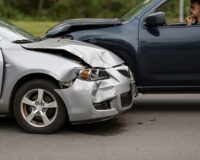Fender benders are a common occurrence on the road, often leading to minor damages and no injuries. However, the stress of the situation can still be overwhelming. Knowing exactly what steps to take after a fender bender can help you handle the situation effectively, ensuring your safety, protecting your rights, and simplifying the insurance process. This guide provides a clear, step-by-step approach to dealing with a non-injury fender bender.
Step 1: Ensure Safety First
Move to a Safe Location
The first priority after any accident is safety. If your vehicle is drivable, move it to the side of the road or a nearby parking lot to avoid blocking traffic and reduce the risk of another accident. If you cannot move the vehicle, turn on your hazard lights to warn other drivers.
Turn on Hazard Lights
Hazard lights are essential in alerting other drivers that you’re stationary and may need assistance. This is particularly important if the accident occurs in a high-traffic area or during low-visibility conditions, such as at night or during heavy rain.
Check for Injuries
Even in a minor accident, it’s crucial to check for any injuries, no matter how small. If anyone is feeling unwell or showing signs of an injury, seek medical attention immediately. Symptoms of injuries like whiplash or concussions can be delayed, so it’s always better to be cautious.
Step 2: Assess the Damage
Initial Inspection
Once you’ve ensured everyone’s safety, inspect the vehicles involved. Look for obvious damage, such as dents, scratches, or broken parts. Note any damage to both your vehicle and the other party’s vehicle.
Document the Scene
Documenting the accident scene is crucial for any potential insurance claims. Take clear photos of the damage to both vehicles, the surrounding area, any skid marks, and the positions of the vehicles before they were moved (if possible). This visual evidence can be invaluable when dealing with insurance companies.
Step 3: Exchange Information
Gather Essential Details
Exchanging information with the other driver is a necessary step after any accident. Make sure to collect the following details:
- Full name and contact information
- Driver’s license number
- Vehicle registration number
- Insurance company and policy number
- License plate number
Ensure that you provide the same information to the other driver. It’s also helpful to note the make, model, and color of the other vehicle.
Use of Technology
If you have a smartphone, use it to take pictures of all the documents you’ve collected. There are also apps available that can guide you through the process and help you store information securely. This can make filing an insurance claim easier and more efficient.
Step 4: Notify the Authorities
When to Involve the Police
In some situations, you may need to call the police, even if the accident is minor and there are no injuries. For example, if the other driver is uncooperative, doesn’t have insurance, or you suspect they are under the influence, it’s best to involve law enforcement. Additionally, some states require a police report for accidents exceeding a certain damage threshold.
Obtaining a Police Report
If the police are called to the scene, they will file a report that documents the accident. This report can be crucial for your insurance claim and if any legal issues arise later. Make sure to get the name and badge number of the officer, as well as a copy of the police report number.
Step 5: Notify Your Insurance Company
Immediate Contact
Contact your insurance company as soon as possible after the accident. Many insurers have specific timeframes in which you must report an accident to avoid complications with your claim.
What to Provide
When notifying your insurer, be prepared to provide:
- The date, time, and location of the accident
- The names and contact information of all involved parties
- A description of the accident and the damage
- Photos of the damage and the accident scene
- The police report number (if applicable)
Being thorough and prompt with your report can help speed up the claims process.
Step 6: Stay Calm and Avoid Admitting Fault
Managing Emotions
Accidents are stressful, and it’s natural to feel a range of emotions. However, it’s important to stay as calm as possible. Take deep breaths and try to keep your emotions in check when speaking with the other driver, witnesses, or authorities.
Importance of Neutrality
It’s crucial not to admit fault at the scene, even if you think you might be responsible. Fault is determined by insurance companies and sometimes the courts, based on evidence. Simply exchange information and let the professionals handle the rest.
Step 7: Consider Seeing a Doctor
Medical Checkup
Even if you feel fine immediately after the accident, it’s a good idea to see a doctor. Some injuries, like whiplash or mild concussions, may not present symptoms right away. A medical professional can assess your condition and ensure that any potential injuries are documented.
Recognizing Delayed Symptoms
Be aware of symptoms that might appear later, such as headaches, dizziness, or neck pain. If you experience any of these, seek medical attention immediately, as they could indicate a more serious injury.
Step 8: Follow Up on Repairs and Claims
Vehicle Repairs
After the initial shock of the accident wears off, you’ll need to get your vehicle repaired. Obtain multiple estimates to ensure you’re getting a fair price. Once you’ve chosen a repair shop, your insurance company may work directly with them to cover the costs.
Insurance Claims Process
The claims process can vary depending on your insurer, but generally, it involves:
- Reporting the accident and providing necessary documentation
- An adjuster assessing the damage
- Receiving a settlement offer
- Getting your vehicle repaired
Keep detailed records of all communications with your insurance company and the repair shop.
Step 9: Learn from the Experience
Reflect on the Incident
Accidents, even minor ones, can be valuable learning experiences. Reflect on what happened and consider what you might do differently in the future. Were you distracted? Could you have been driving more defensively? Use this experience to improve your driving habits.
Consider Preventive Measures
Taking a defensive driving course can enhance your skills and help prevent future accidents. Additionally, consider adding safety features to your vehicle, such as a dashcam, which can provide valuable evidence in the event of an accident.
Conclusion
At Pole Position Autobody, we know that even a minor fender bender can be a major inconvenience. That’s why we’re here to make the repair process as seamless as possible. With over 30 years of experience serving the South Bay area, our team of skilled technicians is dedicated to restoring your vehicle to its pre-accident condition with the highest level of craftsmanship. We use state-of-the-art equipment to ensure that every repair meets the strictest standards of quality and safety. If you’ve been in a collision, trust Pole Position Autobody to get you back on the road quickly and confidently. Contact us to learn more about how we can assist you in your time of need.





